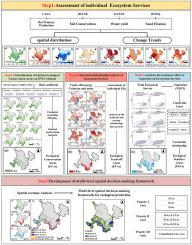多层次生态规划:甘肃国家自然保护区保护、权衡与植被敏感性的整合
IF 10
1区 环境科学与生态学
Q1 ENGINEERING, ENVIRONMENTAL
引用次数: 0
摘要
提高中国天然林保护工程(NFPP)等大型生态恢复项目的可持续性和资源效率,需要先进的决策支持工具。规划常常受到多种生态系统服务(ESs)复杂的相互作用、它们的权衡和环境制约因素的阻碍,从而导致可能低效或不适应的干预措施。本文构建了多层次的空间决策框架,以指导三峡库区甘肃段更清洁、更有效的生态管理。我们量化了2000 - 2020年的4个关键ESs(净初级生产力、产水量、固沙和土壤保持),并使用有序加权平均(OWA)来确定优先生态保护区(ECAs)、生态权衡区(ETAs)的权衡分析和植被(NDVI)驱动的生态敏感区(esa)的约束线分析。与单一目标方法不同,该框架创新地整合了保护优先事项、ES权衡和非线性植被敏感性,实现了从广泛的保护向有针对性的资源高效干预的转变。我们的研究结果显示,GS-NFPPA的ES总体上有了显著改善。该框架确定了覆盖该地区约10.92%的最优经济环境评价,覆盖9.23%的具有激烈生态环境竞争的关键经济环境评价,以及确定生态环境评价供应可能下降的特定土地用途NDVI阈值。这些区域的空间覆盖确定了“综合关键区域”,在这里,高保护价值、权衡和敏感性汇聚在一起,需要最复杂的管理。这一综合的多层次框架为有针对性、差别化的生态管理策略提供了强有力的科学依据。这种预防性和基于证据的方法为提高全球大型环境项目的可持续性提供了一种可转移的模式。本文章由计算机程序翻译,如有差异,请以英文原文为准。

Multi-level ecological planning: Integrating conservation, trade-offs, and vegetation sensitivity for the Gansu NFPP
Enhancing the sustainability and resource efficiency of large-scale ecological restoration programs, such as China's Natural Forest Protection Project (NFPP), requires advanced decision-support tools. Planning is often hindered by the complex interplay of multiple ecosystem services (ESs), their trade-offs, and environmental constraints, leading to potentially inefficient or maladaptive interventions. This study develops a multi-level spatial decision framework to guide cleaner and more effective ecological management in the Gansu section of the NFPP (GS-NFPPA). We quantified four key ESs (Net Primary Productivity, Water Yield, Sand Fixation, and Soil Conservation) from 2000 to 2020 and used Ordered Weighted Averaging (OWA) to identify priority Ecological Conservation Areas (ECAs), trade-off analysis for Ecological Trade-off Areas (ETAs), and constraint line analysis for vegetation (NDVI) driven Ecological Sensitive Areas (ESAs). Unlike single-objective approaches, this framework innovatively integrates conservation priorities, ES trade-offs, and nonlinear vegetation sensitivity, enabling a shift from broad-stroke conservation to targeted, resource-efficient interventions. Our results show significant overall ES improvement across the GS-NFPPA. The framework identified optimal ECAs covering approximately 10.92 % of the region, critical ETAs with intense ES competition covering 9.23 %, and land-use-specific NDVI thresholds that define ESAs where ES provision can decline. The spatial overlay of these zones pinpointed "Comprehensive Key Areas" where high conservation value, trade-offs, and sensitivity converge, demanding the most sophisticated management. This integrated multi-level framework provides a robust scientific basis for targeted, differentiated ecological management strategies. This preventative and evidence-based approach offers a transferable model for enhancing the sustainability of large-scale environmental programs globally.
求助全文
通过发布文献求助,成功后即可免费获取论文全文。
去求助
来源期刊

Journal of Cleaner Production
环境科学-工程:环境
CiteScore
20.40
自引率
9.00%
发文量
4720
审稿时长
111 days
期刊介绍:
The Journal of Cleaner Production is an international, transdisciplinary journal that addresses and discusses theoretical and practical Cleaner Production, Environmental, and Sustainability issues. It aims to help societies become more sustainable by focusing on the concept of 'Cleaner Production', which aims at preventing waste production and increasing efficiencies in energy, water, resources, and human capital use. The journal serves as a platform for corporations, governments, education institutions, regions, and societies to engage in discussions and research related to Cleaner Production, environmental, and sustainability practices.
 求助内容:
求助内容: 应助结果提醒方式:
应助结果提醒方式:


